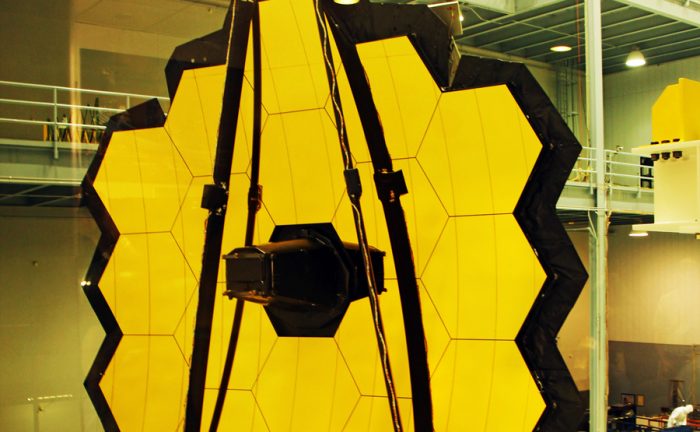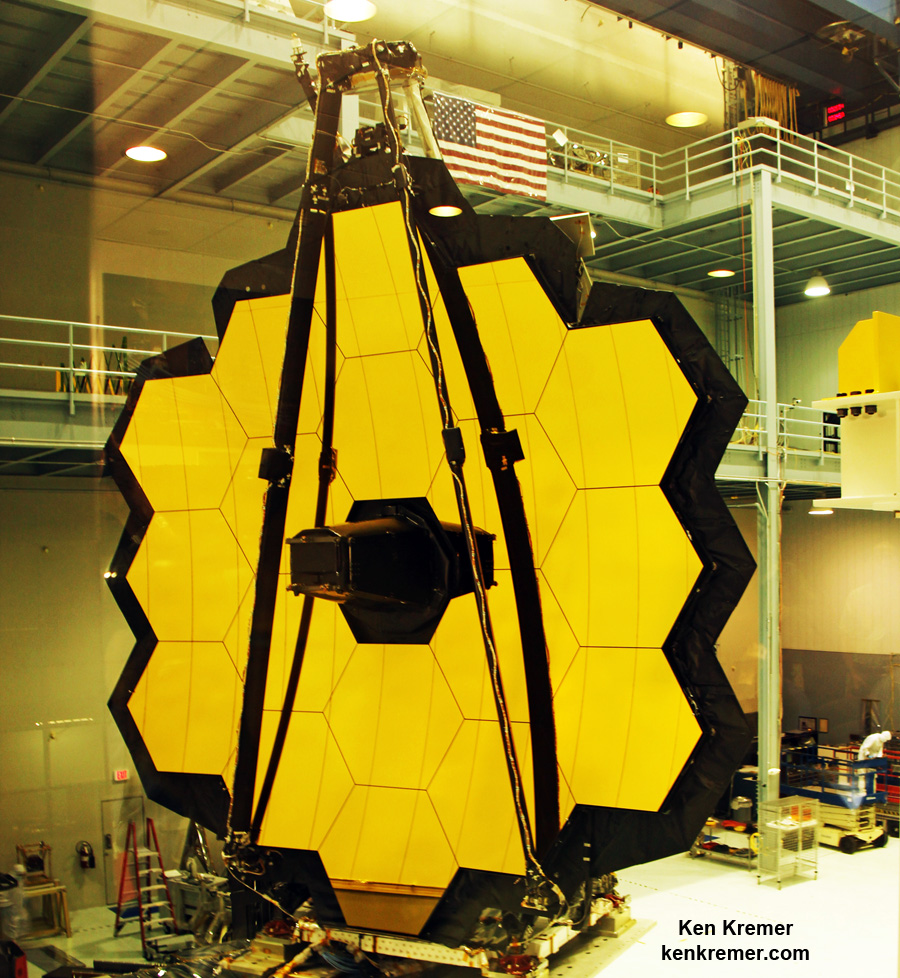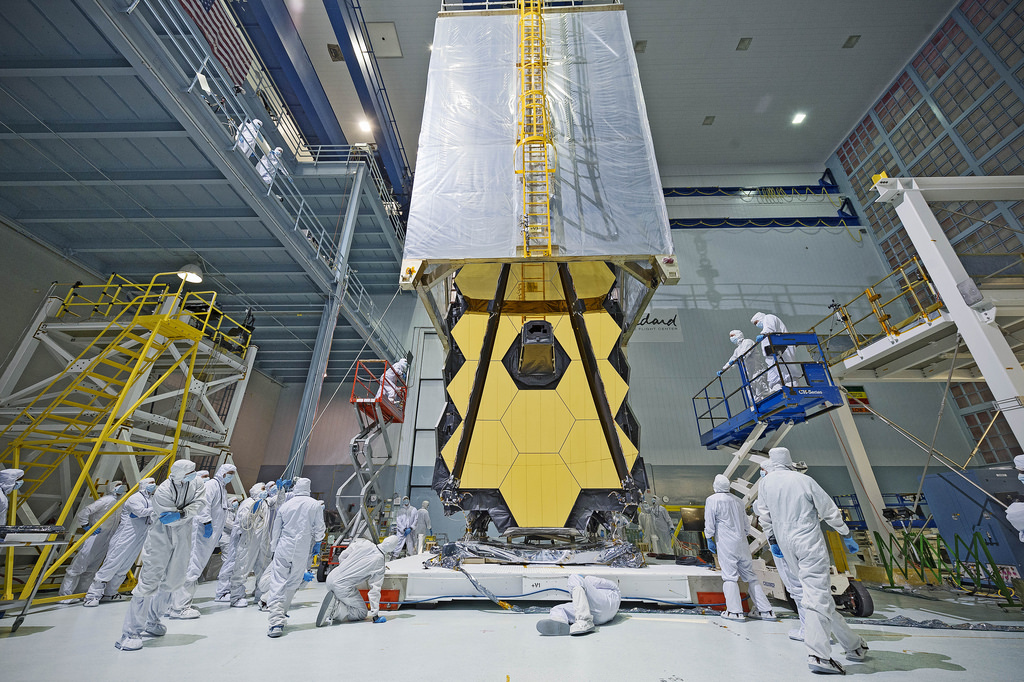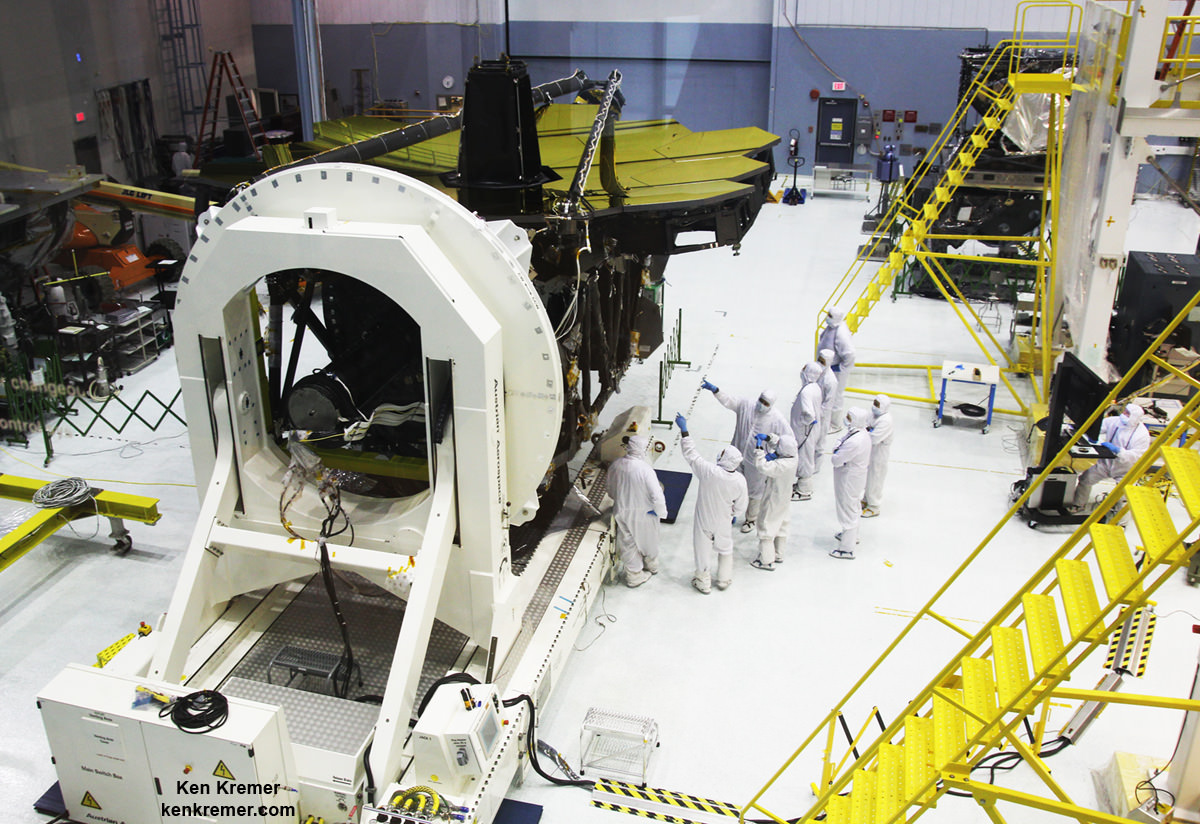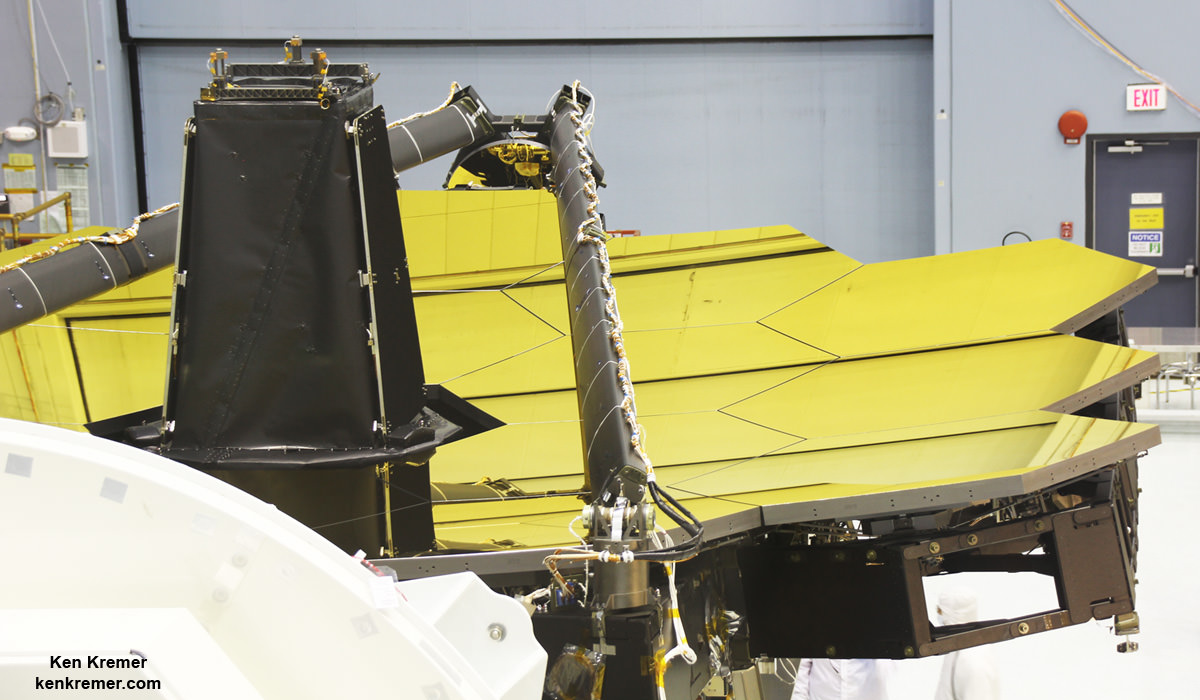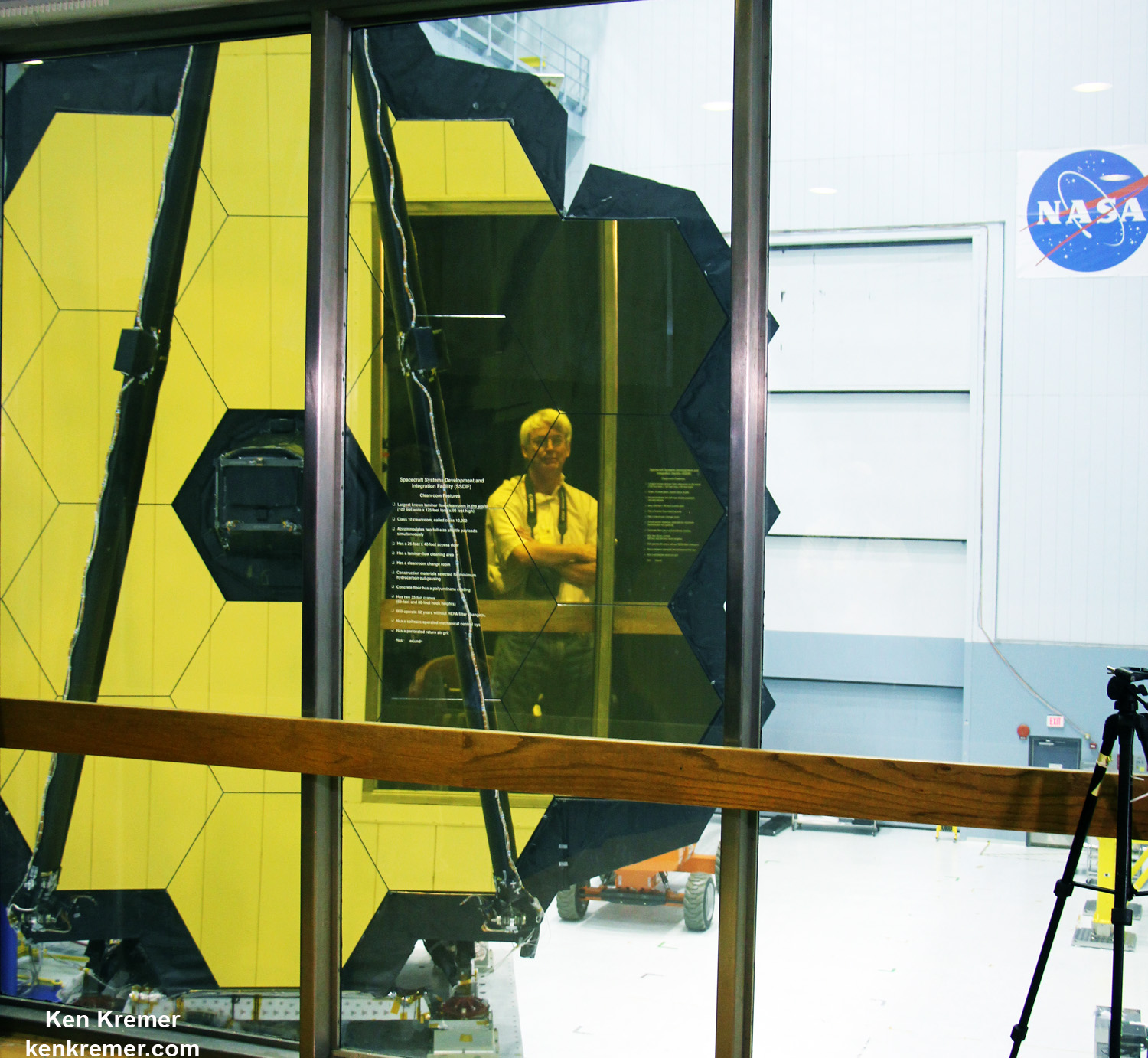
A NASA technician works on the primary mirror of the James Webb Space Telescope, scheduled for launch in October 2018. The telescope will be able to detect light from the earliest stars and galaxies and to search for evidence that distant planets have atmospheres conducive to life. (NASA)
The world’s most expensive telescope is parked for the moment in Greenbelt, Md., shrouded in a protective tent at the NASA Goddard Space Flight Center. In just two years, this long-delayed, $8 billion, cosmos-penetrating instrument is supposed to be nearly a million miles from Earth.
If it works, the James Webb Space Telescope will collect the oldest light in the universe, emitted soon after the big bang, when the first stars lit up and the first galaxies began to form. It will study black holes lurking at the center of galaxies. It will scrutinize the light from planets around distant stars and look for atmospheres you’d expect to see on worlds rioting with life.
But that’s only after an epic journey. It’s not a straight shot from the Washington suburbs to space.
The telescope first must be sealed in a climate-controlled container. Then, sometime in late March or early April, a truck will haul it very slowly and gently in the dead of night along a partially closed Capital Beltway. A lead car will watch for road obstacles and potholes.
Arriving at Joint Base Andrews, the Webb should slide, barely, into the cargo hold of a C-5C military transport plane.
 An artist's illustration of the James Webb Space Telescope. The kite-shaped object beneath the telescope's gold-plated mirror is a sunshield to protect the Webb's instruments. (Northrop Grumman)
An artist's illustration of the James Webb Space Telescope. The kite-shaped object beneath the telescope's gold-plated mirror is a sunshield to protect the Webb's instruments. (Northrop Grumman)Then comes a flight to Houston, to the NASA Johnson Space Center, where it will be tested in a vacuum chamber that will simulate the environment of deep space. From Houston it will be flown to Los Angeles, to a facility run by the project’s primary contractor, Northrop Grumman, where it will be mated with its sunshield and navigational hardware.
Then comes a boat ride, one that will carry the telescope down the southwestern coast of North America and through the Panama Canal to French Guiana. That’s where, in October 2018, it will be blasted into space atop a European Ariane rocket — a quarter-century after the Webb was conceived.
What could go wrong?
“It’s wonderful and terrifying,” says astronomer Heidi Hammel of the Association of Universities for Research in Astronomy, one of six scientists guaranteed observing time with the instrument. “The terrifying part comes because we know that this is rocket science for real, we are taking our fabulous telescope — it’s a beautiful machine — and we’re going to put it on a rocket ship and light the fuse.”
Astronomers have a complicated and anguished relationship with the Webb. It’s amazing. It’s also wildly expensive. And it was supposed to be in space years ago.
John Mather, a Nobel laureate who is the senior project scientist, began working on it in 1995. He and his team had to achieve a long list of innovations to get the Webb built — things like the gold-covered mirrors, the sunshield and the means of keeping everything very cold.
“This job was just so hard, and when you’re at the beginning you don’t have the imagination to see how hard it is. No one had appreciated the difficulty of the test program,” he said this week.
Cost overruns led to budget reviews, battles in Congress, near-death experiences, recrimination and, finally, to a reconfigured budget and timetable that lawmakers approved. The project devoured NASA money that might have gone to other science endeavors. It became known as the telescope that ate astronomy.
The Webb, which includes major contributions from the Canadian and European space agencies, has long been seen as the successor to the Hubble Space Telescope. The latter is still working fabulously but getting long in the tooth.
There have been rumors that the Trump administration could somehow gin up a Hubble repair mission with astronauts on a new shuttle-like spacecraft, but officials at NASA Goddard say they haven’t been asked to plan for anything like that.
The Webb is quite different from the Hubble, starting with the fact that it’s much bigger. The Hubble has a 2.4-meter mirror, but the Webb has 18 hexagonal mirrors that collectively are 6.5 meters — more than 21 feet — in diameter. It can collect seven times as much starlight.
The new telescope can observe the universe in infrared wavelengths of light that are inaccessible to the Hubble. In deep space, shaded from the sun, the Webb is designed to operate under extremely cold conditions. That’s necessary for infrared astronomy because otherwise the heat from its instruments would block out the faint light from distant objects.
As things turned out, the Webb’s problems with schedule may have been fortuitous.
The original goal was to look at very faint objects in deepest space — the very first stars and galaxies, so far away that their light, emitted about 13.7 billion years ago, is only now reaching our solar system. But the Webb may play a key role in the search for habitable worlds that are relatively nearby, orbiting stars in our own galactic neighborhood.
The very first “exoplanet” — a planet orbiting another star — was discovered 22 years ago, right about the time Mather began working on the Webb. Thousands of exoplanets have been found since.
Earlier this week, astronomers announced the remarkable discovery of a system with seven Earth-size planets around a star named Trappist 1, some 39 light-years away. Several have orbits that might allow water, if present, to be liquid at the surface.
[Here’s what you should know about the newfound TRAPPIST-1 solar system]
There’s no way for the Webb or any other current telescope to see these planets directly, because they’re too close to the parent star. But as they transit the star — passing across the face of the star as seen from the telescope — the starlight will dim slightly. That’s how they were discovered.
An atmosphere around a planet will skew the wavelengths of the starlight. Astronomers can then use spectroscopy to discern which kinds of molecules make up the exoplanet atmosphere.
The Hubble has looked at the Trappist system and already has determined that the planets are probably rocky rather than gaseous like Jupiter or Saturn. But the Webb has sophistication the Hubble lacks. The Webb can detect the clear signatures of atmospheres containing water, ozone, oxygen, methane and other molecules. That could provide compelling evidence of a habitable planet.
As astrophysicist Michelle Thaller of NASA points out, while it wouldn’t be the same thing as direct detection of life, it would be a major achievement for the still-young scientific field known as astrobiology.
Closer to home, the Webb’s prime viewing targets include the Great Red Spot of Jupiter, Saturn’s intriguing moon Titan, the dwarf planet Pluto and its moon Charon, plus the gaggle of “trans-Neptunian objects” way out in the exurbs of the solar system — little-known worlds such as Sedna, Quaoar and Makemake.
But first the telescope, which is supposed to begin observing in April 2019, has to function as planned. It would be hard to repair something parked at L2, the Webb’s destination point in space, which is 930,000 miles from Earth on the opposite side of our planet from the sun.
“I can tell you that we’re doing what we need to do to make sure that it’ll work,” Mather said. “You test. And test and test.”
And look for potholes along the way — literally.
Quelle: The Washington Post
-
Inside NASA's Goddard Space Flight Center in Greenbelt, Maryland the James Webb Space Telescope team completed the environmental portion of vibration testing and prepared for the acoustic test on the telescope. Engineers and technicians pushed the telescope (wrapped in a clean tent) through a large set of insulated steel doors nearly a foot thick into the Acoustic Test Chamber, where the telescope will be exposed to the earsplitting noise (and resulting vibration) of launch. These photos show the telescope inside (top) and outside (bottom) the acoustics chamber.
The James Webb Space Telescope is the scientific successor to NASA's Hubble Space Telescope. It will be the most powerful space telescope ever built. Webb is an international project led by NASA with its partners, ESA (European Space Agency) and the Canadian Space Agency.
What happens when the lights are turned out in the enormous clean room that currently houses NASA's James Webb Space Telescope? The technicians who are inspecting the telescope and its expansive golden mirrors look like ghostly wraiths in this image as they conduct a "lights out inspection" in the Spacecraft Systems Development and Integration Facility (SSDIF) at NASA's Goddard Space Flight Center in Greenbelt, Maryland.
The clean room lights were turned off to inspect the telescope after it experienced vibration and acoustic testing. The contamination control engineer used a bright flashlight and special ultraviolet flashlights to inspect for contamination because it's easier to find in the dark.
NASA photographer Chris Gunn said "The people have a ghostly appearance because it's a long exposure." He left the camera's shutter open for a longer than normal time so the movement of the technicians appear as a blur. He also used a special light "painting" technique to light up the primary mirror.
The James Webb Space Telescope is the scientific successor to NASA's Hubble Space Telescope. It will be the most powerful space telescope ever built. Webb is an international project led by NASA with its partners, ESA (European Space Agency) and the Canadian Space Agency.
Quelle: NASA
---
Update: 31.03.2017
.
James Webb telescope: Hubble successor set for yet more tests
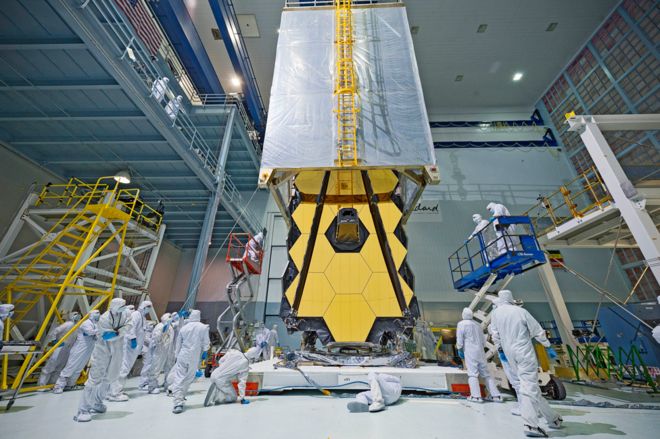 Image copyrightNASA
Image copyrightNASA
Engineers are getting ready to box up the James Webb Space Telescope and send it to Houston, Texas.
The successor to Hubble, due for launch in 2018, is going to be put inside the giant thermal vacuum chamber where they tested the Apollo spaceships.
For 90 days, JWST will get a thorough check-up in the same airless, frigid conditions that will have to be endured when it eventually gets into orbit.
The telescope's aim will be to find the first stars to shine in the Universe.
To achieve this goal, the observatory is being given an enormous mirror and instruments that are tuned to detect some of faintest objects on the sky.
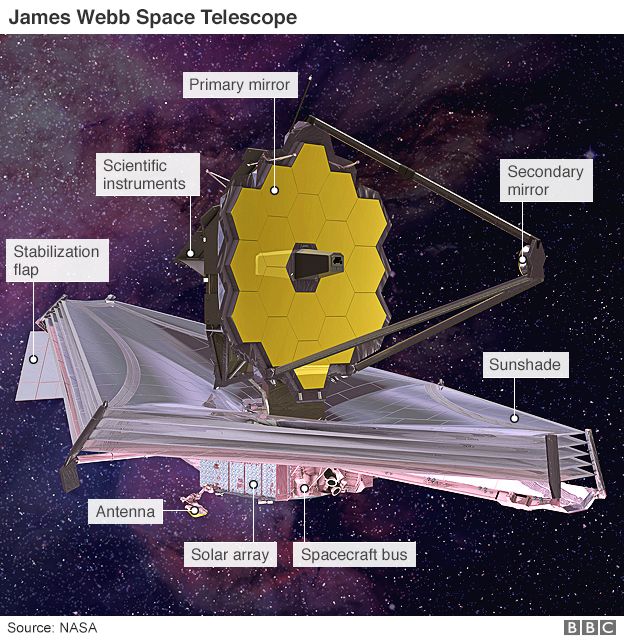
More than two decades in development, JWST is currently passing through the most critical phases on its construction timeline.
Any major technical hiccups now would seriously derail its launch readiness.
The past year has seen the assembly of the main telescope structure, with its 18 beryllium-gold mirror segments, at the US space agency's (Nasa) Goddard centre in Greenbelt, Maryland.
Attached to this structure are Webb's four observing instruments, which sit inside a cage on the rear of the big reflector.
 Image copyrightNASA
Image copyrightNASA
The whole edifice has just gone through vibration and acoustic testing at Goddard. This has simulated the shaking and the roar of the carrier rocket. This will be an Ariane 5 provided by project partner, the European Space Agency.
One vibration run had to be stopped early when unexpected accelerations were detected in the region of the telescope's secondary mirror, but the analysis concluded it was not an issue of significant concern. So far, so good.
Now, JWST must fly to Nasa's Johnson centre at the end of April, or perhaps the beginning of May.
There, it will enter the famous Chamber A. This is the largest testing facility of its kind in the world, and the only one capable of housing an orbiting telescope on JWST's scale.
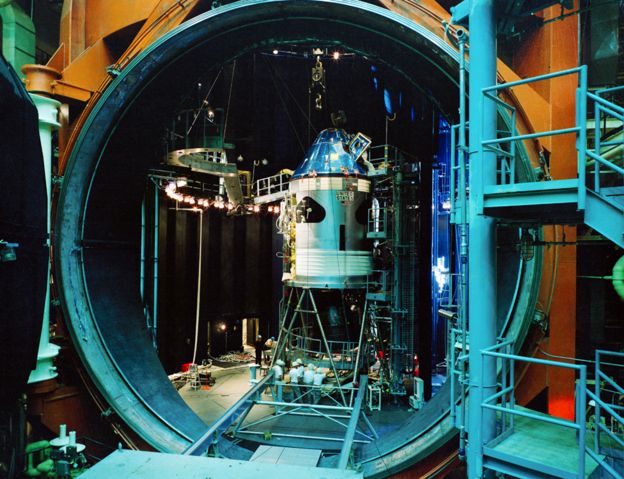 Image copyrightNASA
Image copyrightNASA
Engineers want to know that Webb's mirrors and instruments will function in unison when they are sitting out in space.
The chamber will provide important evidence of that by going super-cold (it can go as low as minus 260 Celsius).
An artificial light source shone on to Webb will ensure everything lines up as it should.
"When we are at temperature, we will unfold the mirrors and move them," explained JWST instrument systems engineer Begoña Vila.
"On orbit, not only do they have to unfold, you have also to confirm the focus for the different instruments.
"If you think about it, with those 18 segments we start with 18 different images of a star, and so we have to move all those images until we have a single one and it is in focus. It's that process that we have to practise," she told BBC News.
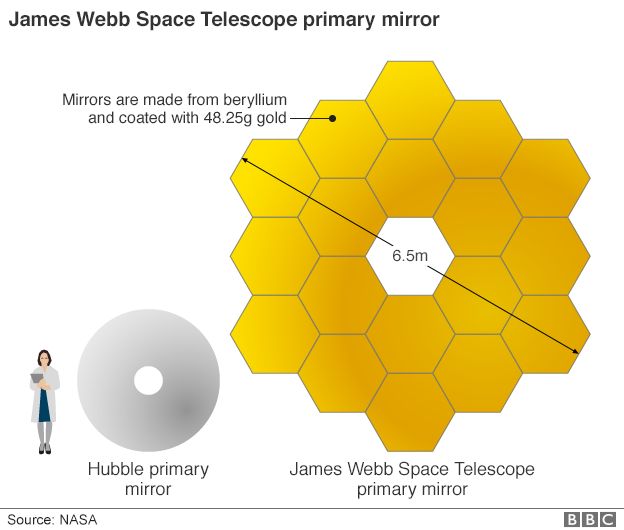
This work should complete in the autumn, but there will be no hiatus in the schedule. Webb will immediately go to Los Angeles to the aerospace company Northrop Grumman.
It is in California where the final elements of the observatory are being put together.
These are the satellite bus, which incorporates the computers, the power and propulsion systems, etc, needed to control Webb in space; and a tennis-court-sized sunshield.
JWST will look at the cosmos in infrared light and so needs to be shaded from the glare and heat of the Sun.
Bus and shield are in their end stages of assembly. Some final components still have to be attached, such as a boom that will deploy the shield once in space, but Northrop Grumman anticipates everything being in position to receive the telescope structure and instruments when they turn up for final integration.
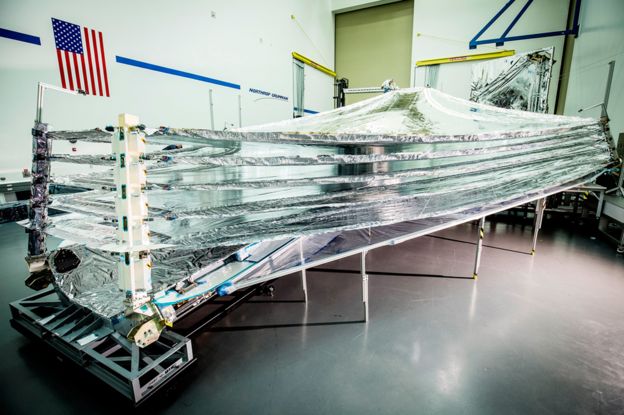 Image copyrightNORTHROP GRUMMAN
Image copyrightNORTHROP GRUMMAN
The finished observatory's journey from LA to the Ariane launch pad in Kourou, French Guiana, will be made by boat.
This is earmarked to begin about six months before the currently slated November 2018 lift-off.
"At this point we are in good shape," confirmed Eric Smith, JWST's programme director and programme scientist.
"We have about five months of scheduled reserve. That's more than is typical for a programme at Nasa but we recognise that this programme is very large and so we know we need to have a little more.
"It's amazing how fast everything is going at this point. But I keep telling people this is the part where you're going to keep finding problems because even though you've tested things all the way up, when you finally put it together some of those things behave just a little bit differently to how you were expecting.
"It's exciting but, boy, it's moving fast," he told BBC News.
 Image copyrightNASA
Image copyrightNASA

